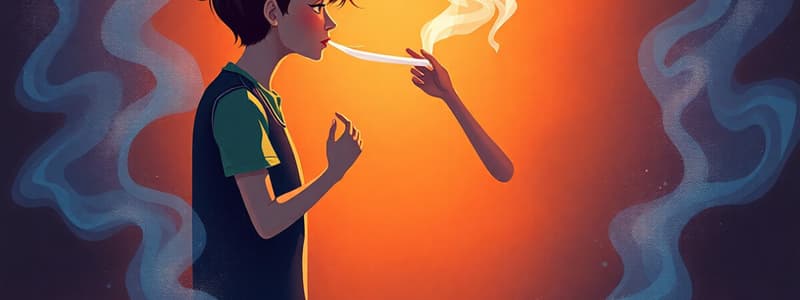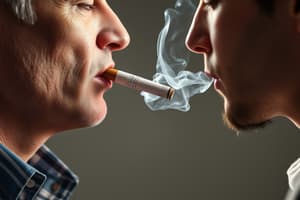Podcast
Questions and Answers
What percentage of Australian adults participated in alcohol consumption in the last week?
What percentage of Australian adults participated in alcohol consumption in the last week?
- 62% (correct)
- 80%
- 75%
- 45%
Which factor contributes to the normalization of smoking behavior according to sociocultural influences?
Which factor contributes to the normalization of smoking behavior according to sociocultural influences?
- Descriptive vs injunctive norms (correct)
- Self-efficacy beliefs
- Nicotine dependence
- High nicotine preference
What is the rate of long-term success for quit strategies for smoking?
What is the rate of long-term success for quit strategies for smoking?
- 15-20% (correct)
- 10-15%
- 20-30%
- 5-10%
What is the definition of risky drinking behavior as mentioned?
What is the definition of risky drinking behavior as mentioned?
What are the implications of alcohol myopia?
What are the implications of alcohol myopia?
What percentage of Year 12 students reported always using condoms?
What percentage of Year 12 students reported always using condoms?
Which theory suggests that sleep helps in adaptation and learning for the brain?
Which theory suggests that sleep helps in adaptation and learning for the brain?
What is the primary concern many individuals have regarding condom use?
What is the primary concern many individuals have regarding condom use?
How long does each sleep cycle last on average?
How long does each sleep cycle last on average?
Which of the following are common factors contributing to insomnia?
Which of the following are common factors contributing to insomnia?
What physiological change is directly associated with sleep deprivation?
What physiological change is directly associated with sleep deprivation?
Which sleep stage involves rapid eye movement and is associated with vivid dreaming?
Which sleep stage involves rapid eye movement and is associated with vivid dreaming?
What is a potential effect of media influence concerning alcohol consumption?
What is a potential effect of media influence concerning alcohol consumption?
What psychological intervention is beneficial for treating insomnia?
What psychological intervention is beneficial for treating insomnia?
What is the relationship between sleep duration of 5 hours or less and life expectancy?
What is the relationship between sleep duration of 5 hours or less and life expectancy?
Flashcards
Smoking prevalence (men vs. women)
Smoking prevalence (men vs. women)
Men historically smoke more than women. In 1945, around 70% of men smoked but by 2019 this had decreased to 12%.
Descriptive vs. Injunctive Norms
Descriptive vs. Injunctive Norms
Descriptive norms describe what people actually do, while injunctive norms describe what people approve of. Media representation influences how normal a behavior appears.
Risky drinking behaviour definition
Risky drinking behaviour definition
Typically defined as consuming 5 or more drinks in a row.
Alcohol's initial vs. continued effects
Alcohol's initial vs. continued effects
Signup and view all the flashcards
Alcohol myopia
Alcohol myopia
Signup and view all the flashcards
Sociocultural factors
Sociocultural factors
Signup and view all the flashcards
Implementation Intention
Implementation Intention
Signup and view all the flashcards
Expectancies (alcohol)
Expectancies (alcohol)
Signup and view all the flashcards
Placebo effect
Placebo effect
Signup and view all the flashcards
Sleep Stages
Sleep Stages
Signup and view all the flashcards
REM sleep
REM sleep
Signup and view all the flashcards
NREM sleep
NREM sleep
Signup and view all the flashcards
Sleep deprivation
Sleep deprivation
Signup and view all the flashcards
Restoration Theory
Restoration Theory
Signup and view all the flashcards
Insomnia
Insomnia
Signup and view all the flashcards
Study Notes
Risky Behaviors
- Smoking: Men smoke more than women, with 70% of men smokers in 1945 declining to 12% in 2019.
- Reasons for smoking:
- Sociocultural factors: Exposure to smoking in media normalizes the behavior, impacting likelihood; descriptive norms (what people do) versus injunctive norms (what people approve of).
- Reinforcement: Smoking offers relaxation, but this effect is often not greater than a non-smoker, or neutral
- Weight control: Quitting smoking can lower cravings and weight gain, although ongoing smoking and subsequent weight gain are still a significant concern.
- Nicotine dependence: This is a factor in the ongoing use of smoking.
- Quitting smoking: Long-term success rates for quit strategies are only 15-20%
- Preventing smoking uptake: Interventions like self-efficacy and implementation intentions; this particular type of intervention had the best outcomes when used to prevent smoking initiation
Alcohol Consumption
- Prevalence: 62% of Australians drank alcohol in the past week; 80% in the past year.
- Risky drinking behavior: Often defined as 5 or more drinks in a row; the drinking pattern is often more damaging than a single occasion, ranging from 20-40% involvement.
- Effects of alcohol:
- Initial: Positive, outgoing, reduced inhibition
- Continued: Depressant, impaired coordination and judgment
- Alcohol myopia: Narrowed attention to immediate stimuli, affecting judgment.
- Long-term: Adverse effects on all organs, increasing mortality risk.
- Health benefits: Moderate use may potentially decrease Low-density lipoprotein (LDL)
- Global impact: 2.5 million net deaths globally related to alcohol use, with an adjustment for some health benefits, 2.25 million.
- Costs: $36 billion annually in Australia due to alcohol-related issues; incidents like assaults, domestic violence, child abuse, and hospitalizations. Costs likely higher than the reported amounts.
Sexual Behavior
- Prevalence: Significant proportions of adolescents engage in sexual activity, with rates increasing through high school; year 10 students at 25% and year 12 at 50%.
- Condom use: Low rates of consistent condom use among high school seniors (40%).
- Alcohol/Substance use: High correlation of risky sexual behavior with alcohol or drug use and intoxication.
- Barriers to safe sex:
- Unrealistically optimistic risk perception: Individuals under-estimate their risk for infections.
- Decreased perceived risk of STIs: Particularly concerning and impacting HIV/AIDS risk reduction strategies
- Beliefs that condoms reduce pleasure: Incorrect perceptions regarding condoms' effect on sexual experience.
- Concerns about initiating discussions around safe sex practices
Sleep
- Definition of sleep: A reversible behavioral state characterized by perceptual disengagement and unresponsiveness to the environment.
- Stages of sleep:
- NREM (non-rapid eye movement): Further divided into stages marked by distinct brainwave patterns and changes in physiological parameters
- REM (rapid eye movement): Associated with dreaming, rapid eye movements, and distinctive brainwave patterns, important for memory consolidation and brain plasticity.
- Sleep duration by age: Varies across stages of life, from infancy to later adulthood.
- Functions of sleep:
- Inactivity theory: Evolutionary protection for safety.
- Energy conservation theory: Reduction of energy consumption. reduced metabolic rate
- Brain plasticity theory: Facilitates adaptation to environments, crucial for learning, memory, and cognitive function. Improves the brain's ability to adapt to its environment.
- Restoration theory: Restores bodily function, repairs tissue, and removes toxins.
- Consequences of sleep deprivation: Impaired cognitive functions, increased risk for physical illness and death, with direct correlation with sleep duration and life expectancy
Insomnia
- Definition (DSM-5): A dissatisfaction with sleep quantity or quality, associated with difficulty initiating, maintaining sleep, or early-morning awakening, present 3 nights a week for 3 months despite adequate opportunities to sleep and causing difficulties in daily functions.
- Prevalence: Affects approximately 20% of the population
- Causes of Insomnia:
- Hyperarousal: Emotional, cognitive, and physiological arousal, contributing to difficulty falling asleep.
- Sleep impairing cognitions: Thoughts about sleep loss, consequences, expectations, etc.
- Dysfunctional sleep habits: Irregular schedules and napping habits, can impact sleep regularity negatively.
- Cognitive Behavioral Therapy for Insomnia (CBT-I): This form of therapy is a useful treatment for insomnia
Studying That Suits You
Use AI to generate personalized quizzes and flashcards to suit your learning preferences.




